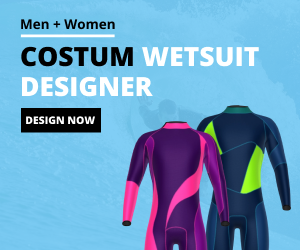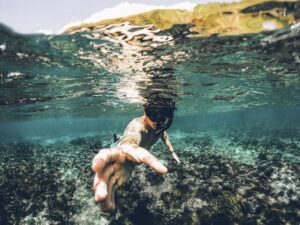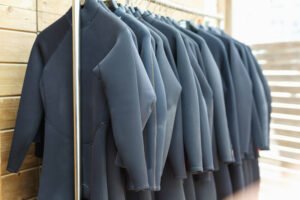Key Takeaways:
- Wetsuits are awesome, as they keep us warm, protected and look cool
- Different wetsuits are suitable for different seasons and temperatures. If you want to be in the water year-round, you will probably need a minimum of two wetsuits
- Thickness of the material and a good fit are paramount if you want good insulation
- Seams, material and zipper placement are the main factors that influence a wetsuit’s quality.
- Add booties, gloves and hoods as necessary
- Take good care of your wetsuit and it will last longer
What is a wetsuit, and why should I use it?
Wetsuits are commonly made out of neoprene – in fact, there are a lot of places around the world where the name “neoprene suit” is more commonly used than “wetsuit” – a material that was invented in 1930 by a chemist in DuPont’s fundamental research group in the US.
A chemist would tell you that the neoprene for a wetsuit is in fact polymerized chloroprene, and that it forms a fabric that contains a huge number of tiny nitrogen bubbles. These are the reasons why wetsuits will keep you warm – and why we are even writing this wetsuit buying guide for you. Without it, the modern wetsuit would simply not exist!
The nitrogen bubbles in your wetsuit are horrible at transmitting heat, which makes them a great insulating material. A wetsuit uses this characteristic and fully takes advantage of it by trapping a thin layer of water, which our bodies can easily heat up to a nice, warm temperature.
The neoprene of the wetsuit, together with the small amount of water, is the perfect insulation against the big, cold body of water in which you swim in! This allows you to stay soaked for longer and even to comfortably swim in areas that would be unbearably cold without a wetsuit, like the Arctic Ocean.
If a wetsuit fits poorly or is manufactured in a way that creates holes and openings (e.g. inferior stitching), this important layer of (warm) water runs out the wetsuit and new (cold) water comes in. Our body then needs to warm this new layer as well, making us feel cold and uncomfortable. This phenomenon is known as “flushing”.
But a well-fitting wetsuit provides more benefits than just insulation: it also protects us from bruises and cuts that you can easily get from swimming objects, a reef, rocks, sea urchins or, depending on your sport, even your own equipment.
Another, often overlooked, plus of wearing a wetsuit is the fact that it blocks the sun from burning your skin. If you don’t think that’s important – you should have a serious talk with your dermatologist. Skin cancer is one of the most common types of cancer! Especially when spending hours in or on the water, good protection from damaging UV-light becomes paramount.
And if that wasn’t enough, wearing a wetsuit has the upside of keeping you on the upside: these thousands of small nitrogen bubbles provide extra buoyancy to the wearer, making you float more easily.
Different thickness and types
You can’t expect a wetsuit that you bought for your trip to the Canaries to protect you from the cold water of the Arctic Ocean. Luckily, through different patterns and various levels of thickness, there are wetsuits available for every climate zone and weather.
Even if your hobby takes place in the same body of water year round, the weather and the seasons still change. It’s therefore common practice for many water sport enthusiasts to have at least two different suits on hand – one for colder circumstances and one for more pleasant temperatures.
This can, of course, grow to a whole collection of wetsuits! If you are in the lucky position to regularly travel to different spots around the world, you will certainly need the right equipment for those varying climates.
In this wetsuit buying guide, we rank them from: the least amount of insulation (for the warmest of climates) to the highest amount of insulation (for the parts of the world that make you shiver just thinking about them…).
Summer wetsuits are, as the name suggests, for the warmest of temperatures (usually 20° C / 68° F or more). They usually have short legs and sleeveless arms and use the thinnest neoprene: 2 mm is the starting point, but 3/2 (3 mm around the torso, 2 around the arms and legs) is the most common thickness for a summer suit. The style and fabric make these wetsuits the most comfortable and flexible choice.
Spring and Fall wetsuits can be short or long sleeved and are usually at least 3/2 thick. With optional gloves and boots, these suits are a bit of an in-between choice.
Winter wetsuits are the warmest option and boast the thickest neoprene. They usually come with gloves and boots and sometimes even a hood, but wearing them is up to you and the climate you face. This category is generally the most versatile and a good choice for your first purchase. Starting from 4/3 mm and ranging up to 5/4 and even more, they can keep you warm in the coldest of temperatures.
Naturally, you want to get the right wetsuits for the climate you will find yourself in. Therefore, this wetsuit buying guide can only give you guidelines – the choice depends ultimately on you and the region you plan on going surfing, swimming or diving in.
Keep in mind, though, that a thicker wetsuit gives you better insulation but will also restrict more your movement. A general rule of thumb is that if the water is below 22° C (72° F) you should bring a wetsuit. To find out what temperature you can expect at your vacation destination, seatemperatures.org is a great resource!
When you sort it by water temperature, it would look something like this:
| Water temperature | Type of wetsuit | Wetsuit thickness | Possible location |
| Over 22° C (72° F) | No wetsuit necessary | – | Indian Ocean, Caribbean |
| 18-22° C (65-72° F) | Summer wetsuit (short sleeves) | 2 mm to 3/2 mm | California, Australia, Peru |
| 14-18° C (58-65° F) | Autumn/Spring wetsuit | 3/2 mm to 4/3 mm | UK, Chile, Portugal |
| 6-14° C (43-58° F) | Winter wetsuit | 5/4 mm | Canada, Alaska |
| 5° C (42° F) or less | Arctic Winter wetsuit | 6/5 mm | Arctic Ocean |
Different wetsuits for different hobbies
The colder the water, the warmer your wetsuit needs to be – simple enough. But to make things more complicated: Finding the perfect wetsuit also depends on what kind of activity you are going for!
Divers will face different water temperatures, depending on how far down they are planning to go. Once they reach a phenomenon called the “thermocline” (ca. 9 m below the surface, depending on the body of water), the water temperatures can drop by 10° C (50° F) or more over the course of 10 m.
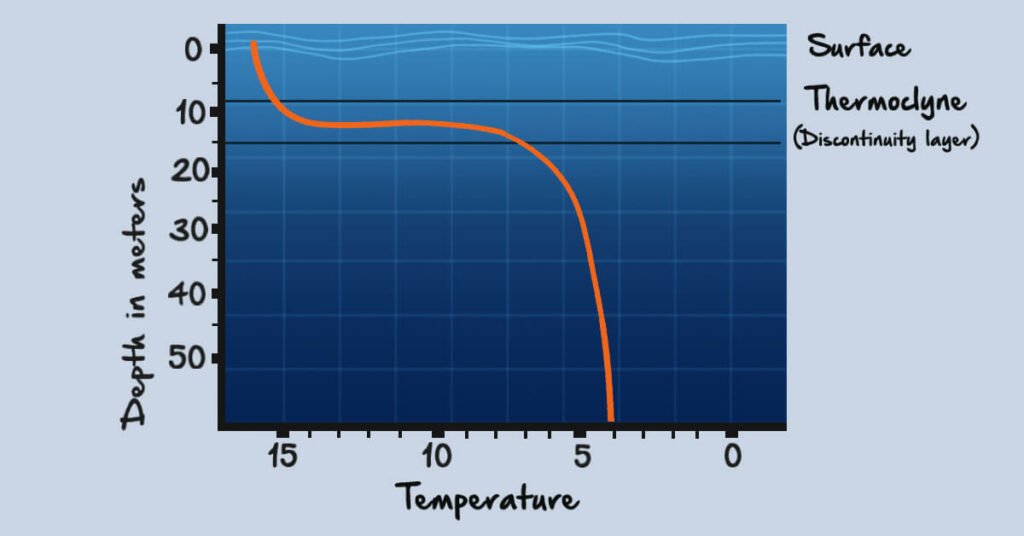
Therefore, divers often find themselves in need of a winter or even arctic wetsuit, even though the surface temperature might be quite pleasant. In order not to be uncomfortable before diving (too hot) and uncomfortable once you are deep down (too cold), custom wetsuits have become very common with divers, as they provide the much-needed flexibility.
Swimmers on the other hand face the challenge of having a maximum of flexibility and as little restriction to their movement as possible. They tend to go for thinner neoprene to increase their speed and make up for the lack of insulation through the heat their bodies create during the activity. A perfect fit is extremely important if you buy a wetsuit for swimming.
(Wave) Surfers are usually the most straight-forward group, as they are happy with a good fit and sufficient insulation. Wind- and kite-surfers, however, have to look out for their wetsuits’ ability to protect them from the cold air rather than the water. As they tend to be out of the water for longer than others, basic neoprene is often not enough to keep them warm. More advanced materials and combinations can help here.
With our custom wetsuits, we are able to cover the needs of all the different water activities with ease. It would even be possible to swim, dive and surf with a single wetsuit of ours and not compromise on speed, warmth or style.
Wetsuit accessories – caps, gloves and booties
If you are planning to only bring your wetsuits to very warm climates – you can basically skip this part of our wetsuit buying guide. All others will sooner or later need a pair of wetsuit booties and possibly gloves or even a hood.
Wetsuits booties
The most common addition to a wetsuit are booties, as they provide protection from sharp objects like sea urchins, insulation against cold water and extra grip for surfers. They are available in a wide variety of materials and thickness, starting from 2 mm and going up all the way to 8 mm.
As usual, thicker material means higher insulation and durability, but also less flexibility. Wetsuit booties are available as round-toe (like a normal shoe) and split-toe (also called “Ninja”).
Wetsuit gloves
In cold water, you can quickly lose sensitivity in your hands, making your time out at sea less pleasurable and even dangerous. Wetsuits gloves are therefore a good investment – not just for winter wetsuits!
They are available as mitten gloves, where every finger (except the thumb) goes into one compartment. As you can imagine, those are not much fun to wear… the alternative are fingered gloves, which offer much more flexibility and even better insulation for a slightly higher price.
Wetsuit hoods
Many winter wetsuits already come with a hood attached, but it is also possible to add a stand-alone hood later. While they are usually only found in cold climates, there is no shame in wearing one in warmer regions if you are prone to get “brain freeze”, ear problems or similar.
The warmest options cover the neck of the wearer as well and are up to 5 mm thick. Putting them on can be a bit of a challenge though, as the neck cover needs to go under your actual wetsuit.
If this seems too much of a hassle, a wetsuit cap can be a better option: they only cover your head, ears, and, depending on the model, little or nothing of your neck. With an average of 2-3 mm thickness, they are also way more flexible, but provide less insulation.
Hint:
If you find it difficult to get into your wetsuit or wetsuit accessories, try putting them on while you are dry (towel yourself off beforehand). Water or sweat make it harder to climb into your wetsuit
How much do I have to spend on my wetsuit?
This wetsuit buying guide would be wholly incomplete if we didn’t talk about the price differences. Because, let’s be honest here, they can be mind-blowing: you can find a cheap one for around $50, or you can easily spend 10 to 20 times more on your wetsuit!
Naturally, with the different price tags come different levels of quality. Here’s a quick rundown of the different categories and where you would fit in (depending on your plans and needs):
Wetsuits under $100 are a good choice if you plan on spending a few days in the water on a vacation. It’s also the ideal price range if you want to pick up a new hobby, like surfing or scuba diving, but you don’t know how often you’ll have time for it – or if you will even stick with it at all. In these cases, it wouldn’t make sense to go all out on a wetsuit.
Wetsuits between $100 and $200 are a good investment if you enjoy that new hobby of yours regularly or can’t see yourself having a vacation without spending much time in the water. You will get a higher quality, which you will certainly enjoy during your many sessions in the water.
Wetsuits above $200 are perfect for you if you spend lots of time in the water. This premium category can handle the kind of regular use a professional surfer, swimmer, diver or serious enthusiast would need.
Many people make their way through this list by starting out as a total novice and becoming more and more serious about their hobby. This development usually reflects in the money they spend on their equipment.
On this journey towards the 200-Dollars-and-more-category, you will probably also accumulate a growing collection of wetsuits. Different styles and levels of thickness will allow you to enjoy your hobby (or profession) in different climate zones and seasons.
Quality differences in wetsuits
We already addressed the differences in quality, but what exactly does that mean? An entry-level wetsuit and a premium one are usually set apart by two factors: the fabric/material and the seams. In addition to these major aspects, there are also minor differences, like the zippers and the style, that should be taken into account.
The big ones: material and seams
One of the biggest aspects in terms of overall quality are the seams of your wetsuit: there are multiple ways of patching the neoprene parts together – some are better than others. You generally have a choice between stitching and gluing, as well as a combination of the two.
Stitches alone can usually be found in entry-level wetsuits, as they tend to be less flexible, create many tiny holes and can even cause chafing – but it creates less cost during the production of your wetsuit. Glued seams (either through tape, “liquid seams” or actual glue) offer a better quality: they are more durable and don’t compromise your flexibility or the integrity of your suit, but have a tendency to be more expensive.
The best result, however, is achieved by combining the two concepts: The neoprene parts are first glued together at their edges before they are sewn with a less compromising stitch (called “blindstitch”). This technique, unsurprisingly, usually comes along with the highest price tag.
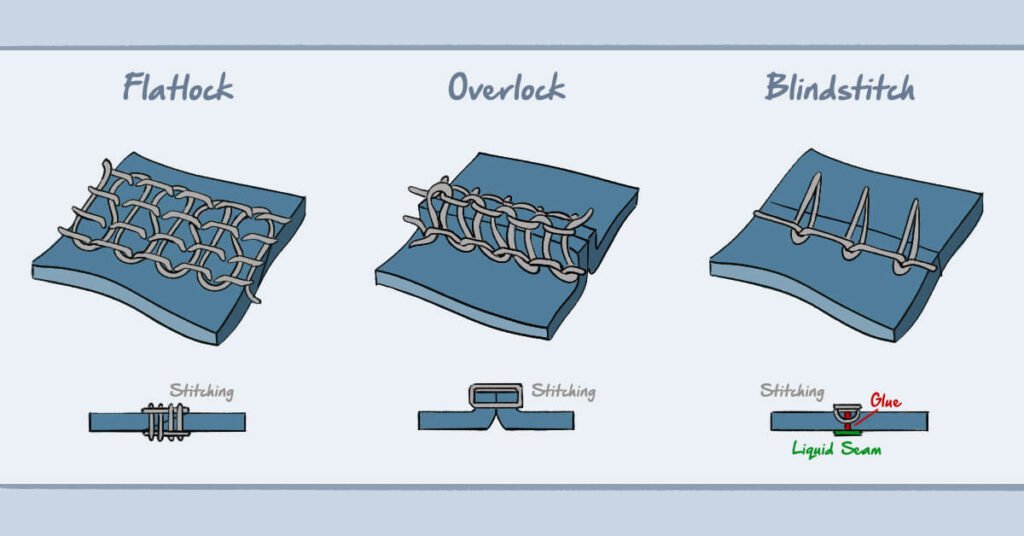
While neoprene is the basic material for wetsuits, other fabrics, chemicals and methods are used to improve its performance drastically. They can increase the insulating quality, make the suit more elastic or increase its ability to withstand damage.
A company that has taken this concept to the extreme is Yamamoto. The Japan-based manufacturer is producing a particularly condensed form of neoprene that can result in a lighter weight and less water actually touching the wearer.
As you will probably have guessed: advanced materials like this are usually found in more expensive wetsuits, while the cheaper ones are made from a more bare-boned neoprene. This is especially true for absolute premium brands, like Yamamoto, and their high-priced, high quality products.
The extreme markup that leading brands charge for their wetsuits has led to a shift in the market in recent years. As they offer high-tech-fabrics, excellent seams and even full customization for a much lower price, more and more surfers, swimmers and divers opt for our custom wetsuits.
Honorable mentions: zippers and style
We can explain to you how to buy the perfect wetsuit, but we can’t help you getting in and out of one. Different positions of zippers and openings can make it easier or harder, but it will never be completely hassle-free.
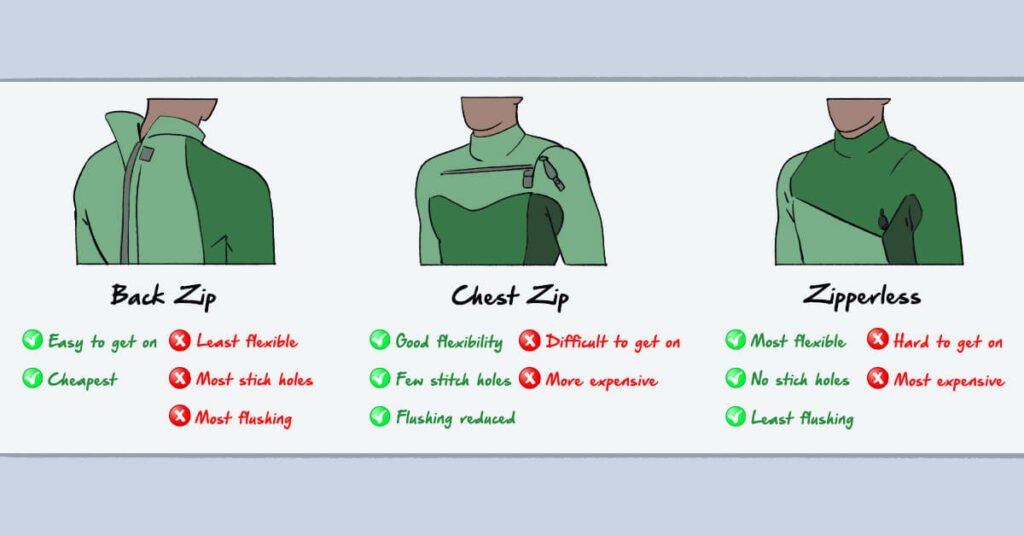
Here, for a change, the cheapest solution is not necessarily the worst: a classic back-zipper is by far the easiest way to enter and exit a wetsuit, and it is generally found on entry-level products. Many surfers swear by this zipper-placement, as it allows them to paddle more comfortably on their bellies; while others consider it not being flexible enough and prefer different styles.
Other suits have the zipper around the upper chest and shoulder area, meaning: you have to pull the wetsuit up over your whole body before closing it. This makes it difficult to put it on, but it means less actual zipper area. The result: less flushing, more flexibility (due to less zipper length and fewer stitches) and also a higher price tag.
Many premium wetsuits use a completely zipperless concept by taking the chest-zip design and using an overlap of fabric to close it. While having the same troubles when it comes to getting into them, once inside, the wearer benefits from a maximum of flexibility and the least amount of flush.
The style of one’s wetsuit has also become an important factor: cheap off the shelf products have a tendency to look gaudy and tacky. But even premium suits aren’t always more fashionable, with many of them giving off weirdly futuristic vibes that seem misplaced in many waters.
In the last few decades, certain brands have established themselves with cooler, less aggressive designs. They often cater specifically to the aesthetic of surfers, swimmers or other groups.
Custom wetsuits have taken the stage more recently, as they provide a high level of personalization in many aspects: fabrics, seams, types and of course style, colors, logos and more can be set to personal taste. Thanks to modern production methods, they even offer competitive pricing, making them a valid option even for small budgets.
Wetsuit renting vs. buying
If you just need a wetsuit for a little snorkeling action during a weekend trip, you hardly need to buy the whole thing – renting one is a perfectly fine option. There are a few downsides, however, of which you should be aware:
- A rental wetsuit is not always the most hygienic option… you never really know who the previous wearer was or what he or she was up to while wearing it.
- Depending on where you are renting your wetsuit, prices can start at around 10 to 15 Dollars a day. This means that after a few rental days, you might actually spend more than if you would just buy a wetsuit
- Many rentals are already worn down, damaged or fit poorly. A wetsuit like that will have limited insulating qualities and can be really annoying – the last thing you need while on vacation!
- It is usually possible to rent a high quality wetsuit in excellent condition, but not without an extra cost. This, in turn, brings you closer to what you would have to pay for your own wetsuit anyway, making a rental less appealing.
- If you are lucky enough to find a rental wetsuit with an acceptable fit, chances are it will still look horrible. When it comes to looking cool and professional, a custom wetsuit with your own design, name or logo and perfect fit is hands down the best option.
Financially speaking, a rental wetsuit only makes sense for very short trips. It takes only a handful of days in the water to make your own wetsuit a worthwhile investment – and that is not even taking into account the hygiene, convenience or style aspects.
Wetsuit fitting guide
You followed our instructions on how to buy the perfect wetsuit and have set your eyes on a suit that has the right thickness, cut, style and price tag for you and your needs. Now comes the time to climb into your new best friend and see if the wetsuit actually fits. But how can you tell what is a good fit?
Here are a few pointers:
Tightness: The material should be tight around your body, but leave enough room for you to breathe (duh). An easy test is to pinch the material, for example around your arms or legs, and pull it away from your body. After releasing it, the neoprene should immediately jump back into its original position. If you do this around your belly, you should even feel something of a suction sensation.
A tight fit is especially important around the arm- and ankle-cuffs, as looseness here can cause major flushing!
Be aware that a wetsuit does not stretch over time! If the suit you bought is too small, it will stay that way and ruin many days at the beach. That’s why it is so important to buy the right size and fit from the start.
Length: Determining if a wetsuit has the right length is pretty straight forward: if you buy a winter wetsuit and parts of your arms or legs are showing between the suit and the boots or gloves, it’s too short. If the suit in question is a short-sleeved summer wetsuit, you have a bit more leeway, but you still need the right torso length. As a general rule: If you have a tight area above your bum that almost looks like a trampoline, the suit you’re wearing is too short.
Resistance: When you move your arms and legs in your wetsuit, a little resistance is normal and expected. Especially when raising your arms into the air or bringing your knees to your chest. However, too much trouble with these motions is a sign of a bad fit. Furthermore, bringing your limbs back down should not create any extra folds under your armpits.
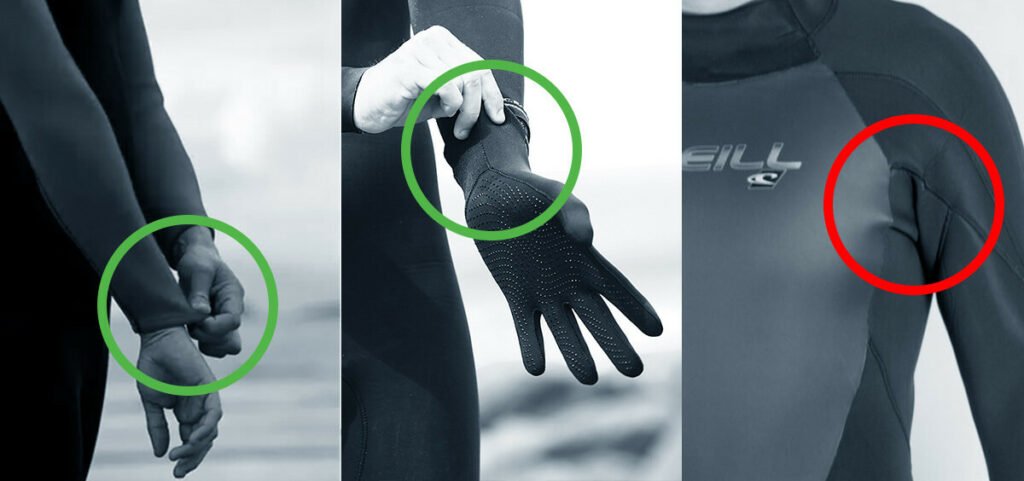
When you try on a wetsuit, you should wear the same swimwear underneath that you are planning to wear in the water. This means board shorts, swimming trunks or a swimsuit for most activities. Some people find it more comfortable to wear a rash guard (lycra shirt) under their wetsuit. Open water swimmers tend to use a speedo-style swimsuit. Ultimately, though, the choice is up to you.
How to take care of your wetsuit
You can significantly increase the lifespan of your wetsuit by taking proper care of it. The first and most important rule here is: avoid heat! This means: no washing machines, tumble-dryers, blow-dryers or ironing your wetsuit. You should also avoid hanging it to dry under direct sun.
After a day in the water, simply wash the wetsuit with fresh, cold water to remove sand and salt. Afterwards, soak it in a mild detergent for about ten minutes. Baby-Shampoo, a mild soap or special wetsuit shampoo are good options. General washing detergents or even “normal” scented shampoo, on the other hand, are too aggressive and can damage your suit.
To dry your wetsuit, hang it inside out and fold it at the waist if necessary. Keep your wetsuit out of direct sunlight, as it can unnecessarily age your suit and compromise its flexibility.
Hint:
Don’t try to scrub wax off of your wetsuit! You have a high chance of damaging the material in the process and the residue will come back anyway.
Summary
Finding a wetsuit that fits like a glove can be quite the hassle. Most brands and their complicated sizing also don’t make it easy for customers to find the right suit. But if you know what to look for, it is absolutely possible to find a good match.
Make sure you get the right thickness and cut for the right climate. There is no point in showing up with a short-sleeved, 2 mm wetsuit in Antarctica – or with an arctic winter wetsuit in the heat of Sri Lanka.
A single wetsuit can cover a surprisingly big range of temperatures, but for most places in the world you need at least two suits if you want to be out and about in all seasons. This is especially true if you are lucky enough to travel to different destinations around the world!
Custom wetsuits can push this flexibility to the maximum and have established themselves as a go-to if you want premium quality, but not pay the ridiculous markups that top-brands charge. Add a pair of wetsuit booties and gloves or a hood if necessary, and you will have most challenges in the water covered.
Don’t be alarmed if the prices seem high at first glance. If you take basic care of your wetsuit, you can get many hours out of it – hundreds, even, if you chose a custom-made or premium-brand suit. This gives wetsuits very high value-for-money, making them a worthwhile investment for anybody with an interest in swimming, surfing or diving.
We hope our tips on how to buy the perfect wetsuit were helpful in clearing up some myths and misunderstandings around neoprene suits. With this wetsuit buying guide, you should be able to find a well-fitting suit for your needs and your budget!



